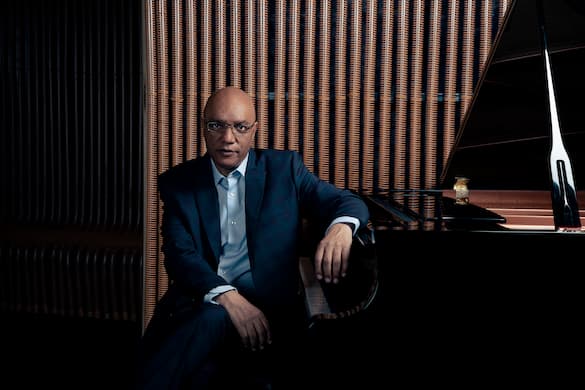Applause-Worthy Billy Childs Compositions Get Their Due at Dizzy’s
Childs is a musical auteur who enriches jazz with techniques and ideas from classical music. His pieces often take the overall outlines of classical forms, but are very much pure jazz in terms of the content.

Billy Childs Quartet
‘The Winds of Change’ (Mack Avenue Jazz)
It’s kind of an unwritten policy in jazz clubs that the crowd mostly applauds for individual improvised solos. Generally speaking, the pre-written ensemble parts of the performance rarely elicit that much attention from the house. On Friday at Dizzy’s, though, those in attendance were not only standing up for the solos, they were cheering Billy Childs’s compositions themselves. (This was pointed out to me, incidentally, by the guy sitting to my left, who turned out to be the highly respected jazz pianist and composer, Aaron Goldberg.)
Billy Childs, who turned 66 on Wednesday, is a musical auteur who enriches jazz with techniques and ideas from classical music. In his case, that often means his pieces take the overall outlines of classical forms, but are very much pure jazz in terms of the content. It’s jazz presented in what can seem like classical shapes.
Mr. Childs has a new album out on March 17, “The Winds of Change,” which he unveiled at Dizzy’s. In both the album and the show, the music is for a quartet, including a trumpet and a rhythm section of bass and drums in addition to Mr. Childs on piano. On the album, those roles are filled by, respectively, Ambrose Akinmusire, Scott Colley, and Brian Blade. At Dizzy’s, they were Sean Jones, Hans Glawischnig, and Ari Hoenig.
The centerpiece of both the album and the show is the title track, “The Winds of Change.” In his spoken introduction, Mr. Childs informed us that the piece was inspired by music from the neo-noir films of the 1970s, specifically Jerry Goldsmith’s in “Chinatown” and Bernard Herrman’s in “Taxi Driver.” On the CD, this is an 11-minute work that almost seems like a movie unto itself.
There is a slow introduction, sort of like the main titles are flashing before us, and then we shift into a faster piece in 6/8, which feels like the plot is starting to get under way. Most of the story — the solos, for instance — takes place here. Eventually, the whole work starts to slow back down into rubato again. Just when you think you’ve got it all figured out, though, Mr. Childs starts to throw in surprises, and the plot twists and turns many more times before we finally reach the end titles.
Mr. Childs introduced “Master of the Game” as having been roughly inspired by the Modern Jazz Quartet — to this day a viable model of how jazz and symphonic ideals might interact. In the same way one hears echoes of Bach throughout much of the MJQ oeuvre, likewise one detects the faint footsteps of John Lewis throughout this piece. In Mr. Childs’s piano parts in particular, I kept being reminded of “La Ronde” and, in particular, “The Queen’s Fancy.” “Master of the Game” also ends effectively, with a tag that goes for baroque.
Both the album and the Dizzy’s show include Mr. Childs’s fascinating take on Chick Corea’s 1972 “Crystal Silence.” This has become perhaps the late pianist’s best-known song, and it’s been arranged and re-arranged by ensembles of many sizes. In a sense, Mr. Childs is taking it back to its roots: “Crystal Silence” was originally a duet between Corea and vibraphonist Gary Burton, and the most salient part of Mr. Childs’s interpretation was an extended duet between piano and trumpet.
As the bass and drums dropped out, Messrs. Childs and Akinmusire proceeded into a very effective duet, in which the trumpet and piano threw very short phrases back and forth. At Dizzy’s, it seemed especially intimate and Mr. Jones remarkably expressive, followed by the first extended bass solo of the set by Mr. Glawischnig.
Mr. Childs concluded the set with “Dance of Shiva,” from his 2015 album “Rebirth,” which, he said, grew out of his fascination with Indian Carnatic music. It actually sounded like it was inspired by everything, a fast and lively piece that frequently switches moods, and in which Mr. Childs briefly turned his piano into a percussion instrument by reaching inside the case and holding down the appropriate strings, so all we got was the sound of the keyboard itself, rather than the usual notes.
The 2015 version featured the excellent Steve Wilson soloing on alto saxophone, but here Mr. Jones essayed this rather breathless, tricky melody, with its many stop-and-start rhythmic shifts, as if he’d played it a zillion times before.
Before introducing the last tune, Mr. Childs described his music, and what it takes to play it, as being “chops intensive.” That’s very accurate, but it also should be said that this music is heart and emotionally intensive as well.

